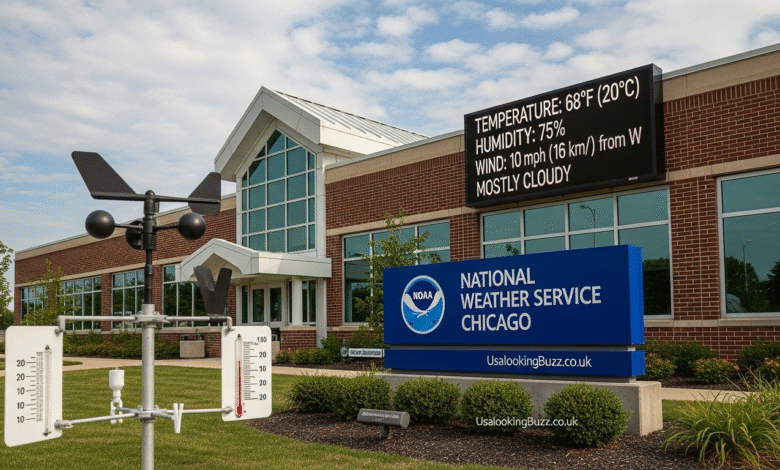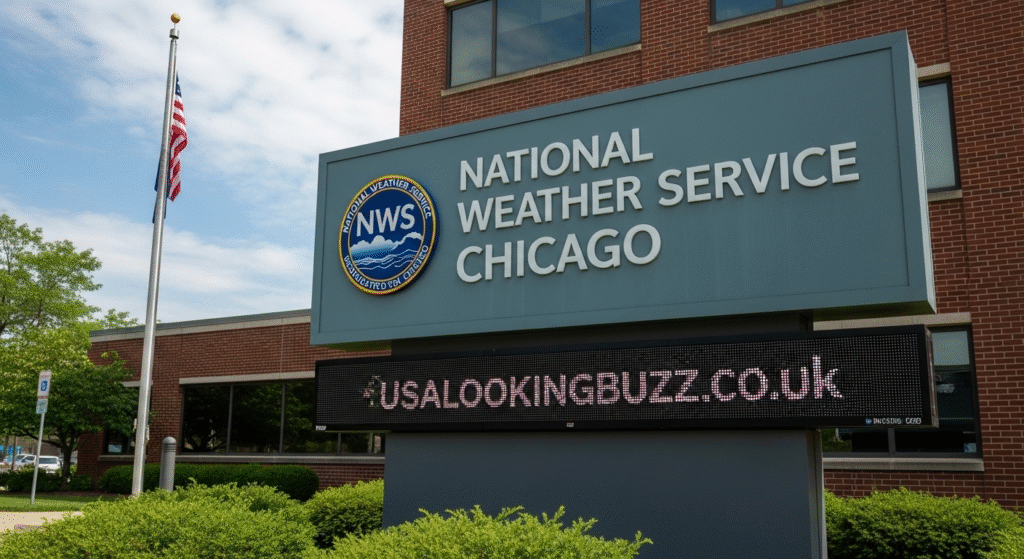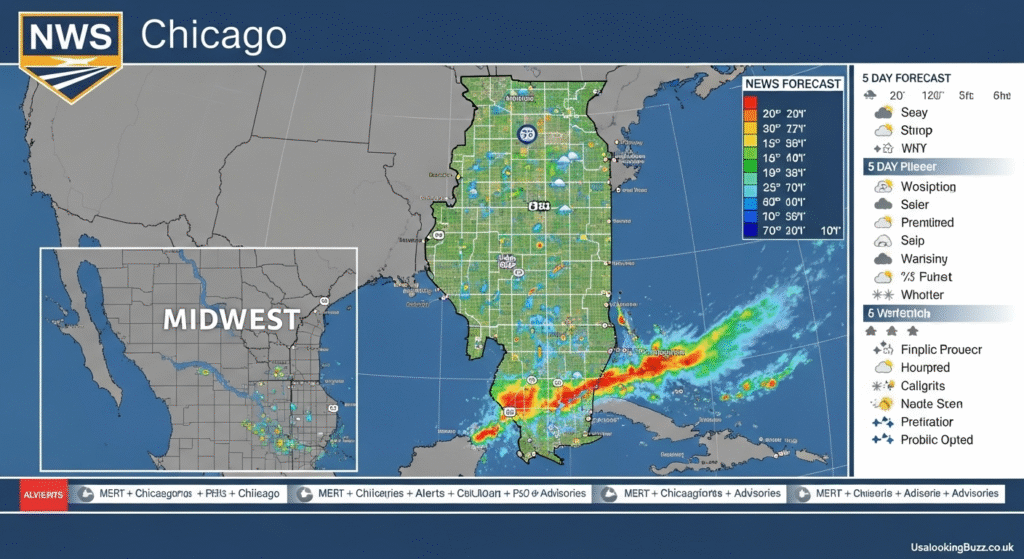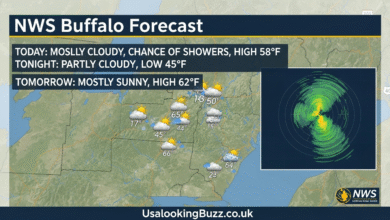Ultimate Guide to NWS Chicago Weather Forecasts

Introduction
You’re planning a weekend trip to the lakefront, and suddenly you wonder: should I bring an umbrella? Will that storm system everyone’s talking about actually hit? This is where NWS Chicago becomes your best friend. The National Weather Service Chicago office isn’t just another weather app on your phone. It’s the authoritative source that keeps millions of people safe and informed across northeastern Illinois and northwestern Indiana.
I’ve relied on NWS Chicago countless times, especially during severe weather events. There’s something reassuring about getting information directly from meteorologists who understand our region’s unique weather patterns. This article will walk you through everything you need to know about NWS Chicago, from understanding their forecasts to staying safe during extreme weather.
Whether you’re a longtime Chicago resident or new to the area, you’ll discover how to make the most of this free, reliable resource.
What Is NWS Chicago and Why It Matters
NWS Chicago is the local office of the National Weather Service serving northeastern Illinois, northwestern Indiana, and portions of southeastern Wisconsin. The office is located in Romeoville, Illinois, and operates 24 hours a day, seven days a week.
Unlike commercial weather services, NWS Chicago is run by the federal government through NOAA (National Oceanic and Atmospheric Administration). This means their primary goal isn’t clicks or advertising revenue. It’s public safety and accurate forecasting.
The office covers an area home to over 10 million people. That’s a huge responsibility. Their meteorologists issue watches, warnings, and advisories that protect lives and property. They also provide specialized forecasts for aviation, marine interests, and emergency management.
You might not realize it, but most weather apps and news stations get their data from the National Weather Service. NWS Chicago is the original source. Going directly to them gives you the most detailed and up-to-date information available.
Understanding NWS Chicago’s Forecast Products
Daily Weather Forecasts
The NWS Chicago website offers detailed forecasts that go far beyond “sunny” or “rainy.” You’ll find hour-by-hour predictions, extended outlooks, and probability percentages for precipitation.
The forecast discussion is particularly valuable. This is where meteorologists explain their thinking in plain language. You can read why they expect certain conditions and what uncertainties exist. It’s like getting a behind-the-scenes look at weather prediction.
I always check the forecast discussion before major outdoor events. It helps me understand not just what might happen, but how confident the forecasters are about their predictions.
Severe Weather Watches and Warnings
This is where NWS Chicago really shines. Understanding the difference between watches and warnings could save your life.
A watch means conditions are favorable for severe weather. It’s issued several hours in advance. Think of it as “be prepared.” A warning means severe weather is happening or imminent. This requires immediate action.
The Chicago area sees various severe weather threats throughout the year. Tornadoes in spring and summer. Severe thunderstorms with damaging winds. Winter storms that can dump heavy snow. NWS Chicago monitors all of these threats constantly.
Special Weather Statements and Advisories
Not every weather event rises to warning level, but it still might affect your plans. That’s where advisories and special weather statements come in.
You might see a wind advisory when gusts could reach 40 mph. A winter weather advisory when a few inches of snow are expected. These products help you prepare without causing unnecessary alarm.
How to Access NWS Chicago Information
The Official Website
The main NWS Chicago website (weather.gov/lot) is your primary resource. Yes, it looks a bit old-school compared to flashy weather apps. But what it lacks in design, it makes up for in depth and reliability.
The homepage shows current conditions, active alerts, and the latest forecast. You can click on any location on the interactive map to get specific information for that area.
The site includes radar imagery, satellite views, and observation data from weather stations across the region. You can even view lightning strike data and river levels.
Social Media Channels
NWS Chicago maintains active social media accounts on Twitter (now X) and Facebook. These channels provide quick updates, especially during severe weather events.
The meteorologists often share educational content too. You’ll learn about weather phenomena, forecasting techniques, and historical weather events in the Chicago area.
Following them on social media gives you another layer of awareness. Sometimes a quick tweet alerts you to changing conditions before you’d think to check the full website.
Weather Radio
NOAA Weather Radio is an often-overlooked resource. These specialized radios receive broadcasts directly from NWS Chicago on dedicated frequencies.
The best weather radios have tone alerts that automatically activate when warnings are issued for your county. This can be lifesaving during overnight severe weather when you might be asleep.
You can find weather radios at most electronics stores for $20 to $50. It’s a small investment for peace of mind, especially if you live in a tornado-prone area.

Unique Weather Challenges in the Chicago Area
Lake Michigan’s Influence
Lake Michigan dramatically affects Chicago’s weather. The lake moderates temperatures, creates lake-effect snow, and influences storm development.
In summer, the lake keeps the immediate shoreline cooler. A 90-degree day inland might only reach 75 near the lake. This is great if you’re at the beach, frustrating if you forgot a jacket.
Winter brings lake-effect snow. When cold air masses move over the relatively warm lake water, they pick up moisture and dump it as snow. Areas south and east of Chicago can see dramatically higher snowfall totals than areas just miles away.
NWS Chicago meteorologists are experts at predicting these lake effects. Their local knowledge makes their forecasts more accurate than national models.
Urban Heat Island Effect
Chicago’s dense urban environment creates a heat island. The city center runs several degrees warmer than surrounding suburbs, especially at night.
This affects everything from energy costs to air quality to the intensity of thunderstorms. NWS Chicago factors this into their forecasts and heat advisories.
During heat waves, the urban heat island effect can be dangerous. The combination of high temperatures and humidity creates life-threatening conditions, especially for vulnerable populations.
Severe Weather Season
Spring and early summer bring the highest risk of severe thunderstorms and tornadoes to the Chicago area. The clash of warm, humid air from the Gulf of Mexico with cooler air from Canada sets the stage.
NWS Chicago issues tornado warnings with remarkable accuracy. Their use of dual-polarization radar helps them detect rotation within storms before tornadoes form.
The Chicago region averages about 10 to 12 tornado warnings per year. While that sounds frightening, remember that most tornadoes in our area are brief and relatively weak. Still, every warning should be taken seriously.
How NWS Chicago Keeps You Safe During Winter
Blizzard Warnings and Winter Storm Warnings
Chicago winters are legendary. NWS Chicago helps you prepare with detailed winter weather forecasts and warnings.
A winter storm warning means significant snow, sleet, or ice is expected. A blizzard warning is more serious. It means heavy snow combined with winds of at least 35 mph, creating dangerous whiteout conditions.
The lead time for winter storm warnings has improved dramatically. You often get 24 to 48 hours notice before major snow events. This gives you time to stock up on supplies and adjust your plans.
Wind Chill Advisories and Warnings
Extreme cold is another winter hazard. Wind chill describes how cold it feels when you combine air temperature with wind speed.
A wind chill advisory is issued when wind chills are expected to reach minus 20 to minus 29 degrees Fahrenheit. A wind chill warning means even colder conditions, potentially reaching minus 30 or below.
These dangerous temperatures can cause frostbite in minutes. NWS Chicago’s early warnings help schools, businesses, and individuals prepare. Many schools make closure decisions based directly on NWS forecasts and warnings.
Lake-Effect Snow Forecasting
Predicting lake-effect snow is one of the most challenging aspects of Chicago-area forecasting. Small shifts in wind direction or lake temperature can dramatically change snow amounts and locations.
NWS Chicago uses specialized models and local expertise to forecast these events. They often issue advisories for narrow bands of heavy snow that might only affect a few counties.
I’ve seen situations where one suburb gets 10 inches while a town just 15 miles away gets nothing. That’s the nature of lake-effect snow, and it’s why local NWS forecasts matter so much.
Summer Weather and NWS Chicago
Heat Waves and Excessive Heat Warnings
Chicago summers can be brutal. High temperatures combined with humidity create dangerous heat index values.
NWS Chicago issues excessive heat warnings when the heat index is expected to reach 105 degrees or higher. These warnings often include information about cooling centers and safety tips.
Heat is actually one of the deadliest weather phenomena. More people die from extreme heat than from tornadoes, hurricanes, and floods combined. NWS Chicago’s heat warnings help prevent heat-related illness and death.
Severe Thunderstorm Warnings
Summer thunderstorms in Chicago can be intense. Damaging winds, large hail, and frequent lightning are common threats.
When a severe thunderstorm warning is issued, it means the storm contains winds of at least 58 mph or hail at least one inch in diameter. These storms can down trees, damage roofs, and create dangerous conditions.
The warnings specify exactly which areas are threatened and when the storm will arrive. This geographic and temporal specificity helps you make informed decisions about seeking shelter.
Air Quality Forecasts
NWS Chicago also provides air quality forecasts during summer. High temperatures and sunlight create conditions favorable for ozone formation.
On poor air quality days, people with respiratory conditions should limit outdoor activities. The forecasts help you plan accordingly and protect your health.
Using NWS Chicago for Planning and Decision Making
Event Planning
Planning an outdoor event? Start with NWS Chicago forecasts. The detailed outlooks help you choose dates and make backup plans.
For events more than a week out, check the Climate Prediction Center’s outlooks for temperature and precipitation trends. As the date approaches, the standard forecasts become more reliable.
I always recommend having a weather plan for outdoor events. Know what conditions would trigger a postponement. Monitor NWS Chicago for updates in the days leading up to your event.
Travel Safety
Before a road trip, check the NWS forecast for your entire route. Winter travel especially requires careful planning based on weather conditions.
The NWS website has a handy feature where you can enter a route and see forecasts for each segment. This helps you time your departure to avoid the worst conditions.
For air travel, NWS Chicago provides aviation forecasts that airlines use for flight planning. Delays due to thunderstorms or winter weather are usually predictable if you check the forecast.
Agriculture and Outdoor Work
Farmers, landscapers, and construction workers rely on detailed NWS forecasts. Knowing when rain will arrive or when temperatures will drop affects scheduling and productivity.
The frost and freeze forecasts in spring and fall are particularly important for agriculture. NWS Chicago issues these with several days lead time when possible.
The Technology Behind NWS Chicago Forecasts
Doppler Radar
NWS Chicago operates a WSR-88D Doppler radar located in Romeoville. This powerful tool detects precipitation, measures its intensity, and identifies rotation within storms.
The radar scans the atmosphere continuously, providing real-time data. During severe weather, meteorologists can see storms develop and track them minute by minute.
Dual-polarization technology allows the radar to determine what type of precipitation is falling. This helps distinguish between rain, snow, sleet, and hail. It can even detect debris being lofted by tornadoes.
Weather Balloons and Surface Observations
Twice daily, at midnight and noon Central Time, NWS offices release weather balloons. These balloons carry instruments that measure temperature, humidity, pressure, and wind as they rise through the atmosphere.
This upper-air data is crucial for understanding atmospheric conditions and improving forecast models. Surface weather stations provide ground-level observations every hour.
All this data feeds into computer models that help meteorologists predict future weather patterns.
Computer Models and Human Expertise
Modern weather forecasting relies heavily on computer models. These mathematical simulations process vast amounts of data to predict how the atmosphere will evolve.
But models aren’t perfect. That’s where human meteorologists come in. NWS Chicago forecasters interpret model output, apply local knowledge, and use their experience to create the best possible forecast.
The combination of advanced technology and human expertise makes NWS Chicago forecasts remarkably accurate, especially for short-term predictions.
Common Misconceptions About Weather Forecasting
Why Forecasts Sometimes Change
You’ve probably noticed forecast changes as an event approaches. This frustrates people, but it’s actually a sign of good forecasting practice.
The atmosphere is chaotic. Small changes in initial conditions can lead to different outcomes. As new data arrives, forecasts are updated to reflect the latest information.
Think of it like driving to a destination. You have a general route, but you adjust based on traffic conditions and road closures. Forecast updates work the same way.
Forecast Accuracy and Lead Time
Short-term forecasts are very accurate. Today’s forecast for tomorrow is correct about 90% of the time. But accuracy decreases as you look further ahead.
Seven-day forecasts are useful for planning but shouldn’t be treated as gospel. The general trend is usually right, but specific details may change.
Beyond 10 days, forecasts become much less reliable. Weather is simply too complex to predict with precision that far in advance.
How to Interpret Weather Graphics and Maps
Understanding Radar Imagery
The NWS radar image uses colors to show precipitation intensity. Green and yellow indicate light to moderate rain or snow. Oranges and reds show heavy precipitation. Purples indicate extremely heavy rain or large hail.
The radar loops show storm movement and help you estimate when precipitation will reach your location. Watching the loop for a few minutes gives you much more information than a single snapshot.
Reading Forecast Charts
NWS forecast graphics can look complicated, but they convey valuable information. Temperature maps show expected highs and lows. Precipitation probability maps indicate where rain or snow is most likely.
The forecast discussion often references these graphics, explaining what the maps show and why certain areas might see different conditions.
Take a few minutes to familiarize yourself with common graphics. They’re powerful tools for understanding the weather story.
Staying Safe: Emergency Preparedness Tips
Creating a Weather Safety Plan
Every household should have a weather safety plan. Know where to shelter during tornadoes. Have emergency supplies for winter storms. Identify cooling locations for heat waves.
Your plan should include multiple ways to receive weather warnings. The NWS Chicago website, weather radio, and smartphone apps provide redundancy.
Practice your plan, especially if you have children. Knowing what to do in advance reduces panic during actual emergencies.
Emergency Supply Kit
Keep essential supplies on hand. For winter storms, you need food, water, flashlights, batteries, and blankets. A battery-powered weather radio ensures you stay informed even if power fails.
In summer, have bottled water and ways to stay cool during heat waves and power outages. First aid supplies are important year-round.
Review and refresh your emergency kit seasonally. Check expiration dates on food and batteries.
When to Take Warnings Seriously
Every warning deserves attention, but some situations require immediate action. Tornado warnings and flash flood warnings are life-threatening emergencies.
When a tornado warning is issued for your area, get to your safe place immediately. Basements are best. Interior rooms on the lowest floor without windows are the next safest option.
For flash flooding, never drive through flooded roads. Turn around, don’t drown. Most flood deaths occur in vehicles.
The Future of Weather Forecasting in Chicago
Technological Advances
Weather forecasting continues to improve. New satellite technology provides higher-resolution imagery. Faster computers run more sophisticated models. Machine learning helps identify patterns humans might miss.
NWS Chicago will incorporate these advances, leading to even better forecasts and longer lead times for severe weather warnings.
The next generation of weather satellites will provide images every 30 seconds instead of every five minutes. This dramatic increase in temporal resolution will revolutionize severe weather monitoring.
Climate Change Impacts
Our climate is changing, and NWS Chicago is adapting. The region is experiencing more extreme precipitation events. Heat waves are becoming more intense and frequent.
Understanding these long-term trends helps NWS Chicago provide better guidance for planning and preparedness. The historical perspective they offer is invaluable for seeing how our weather patterns are evolving.

Conclusion
NWS Chicago is more than just a weather forecast. It’s a comprehensive safety system that protects millions of people every day. From severe thunderstorms to winter blizzards, from heat waves to flash floods, NWS Chicago provides the accurate, timely information you need to stay safe.
The next time you check the weather, consider going directly to the source. The NWS Chicago website might not be the prettiest, but it’s the most reliable. Bookmark weather.gov/lot and check it regularly. Follow them on social media for quick updates. Consider investing in a weather radio for overnight protection.
Weather affects every aspect of your life. Having access to the best possible forecasts helps you make better decisions. Whether you’re planning a picnic or preparing for a blizzard, NWS Chicago has your back.
How do you currently stay informed about weather in the Chicago area? Have you experienced a severe weather event that made you appreciate accurate forecasting? Share your thoughts and experiences in the comments below.
FAQs
What does NWS stand for? NWS stands for National Weather Service, the United States government’s official weather forecasting agency operated by the National Oceanic and Atmospheric Administration (NOAA).
How accurate are NWS Chicago forecasts? NWS Chicago forecasts are highly accurate, with next-day forecasts being correct about 90% of the time. Accuracy decreases for longer-range forecasts, but they remain among the most reliable available for the Chicago region.
What area does NWS Chicago cover? NWS Chicago serves northeastern Illinois, northwestern Indiana, and portions of southeastern Wisconsin. This includes the Chicago metropolitan area and surrounding counties, covering over 10 million people.
How far in advance are tornado warnings issued? Tornado warnings are typically issued 10 to 15 minutes before a tornado strikes. Tornado watches, which indicate favorable conditions, are usually issued several hours in advance to give people time to prepare.
What’s the difference between a watch and a warning? A watch means conditions are favorable for severe weather to develop. A warning means severe weather is occurring or imminent and requires immediate action to protect life and property.
Where is the NWS Chicago office located? The NWS Chicago office is located in Romeoville, Illinois. The office operates 24 hours a day, 7 days a week, with meteorologists constantly monitoring weather conditions across the region.
How can I receive weather warnings at night? Purchase a NOAA Weather Radio with tone alert capability. These radios automatically activate when warnings are issued for your county, even while you sleep. You can also enable emergency alerts on your smartphone.
Why does lake-effect snow only hit certain areas? Lake-effect snow depends on wind direction, temperature differences between the lake and air, and local geography. Narrow bands of heavy snow form where conditions align perfectly, while nearby areas may see little or no snow.
Can I tour the NWS Chicago office? NWS Chicago occasionally offers public tours and open houses. Check their website or social media for announcements about upcoming events. These tours provide fascinating behind-the-scenes looks at weather forecasting operations.
How do I report severe weather to NWS Chicago? You can report severe weather through the NWS website, their social media channels, or by calling the office directly. Your reports help meteorologists verify warnings and improve future forecasts. Include specific details like hail size, wind damage, or measured rainfall amounts.
Also Read Usalookingbuzz.co.uk
